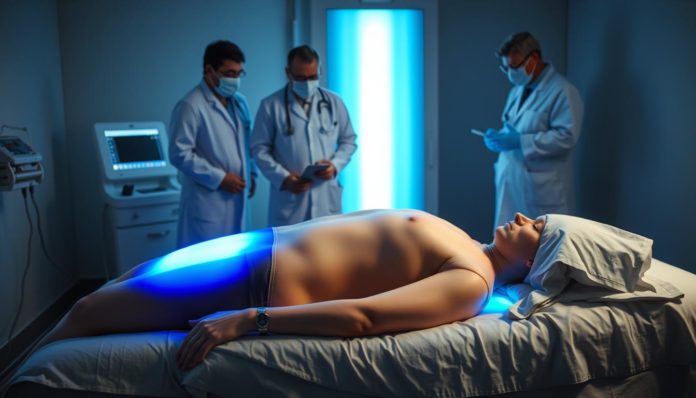Did you know almost 1 in 9 men will get prostate cancer in their life? Prostate cancer is a major cause of cancer deaths worldwide. There’s a new treatment on the rise: Photodynamic Therapy (PDT) for Prostate Cancer. It’s a game-changer because it’s less invasive and very focused.
PDT is not like the usual treatments. It uses advanced techniques to kill cancer cells but saves the healthy ones. It makes use of things like Chlorin E6 and new light systems. The Heidelberg Clinic for Prostate Therapy has shown these modern methods can really improve how well treatments work. This could change how doctors treat prostate cancer.
Introduction to Photodynamic Therapy for Prostate Cancer
Photodynamic therapy (PDT) for prostate cancer uses light and special drugs to fight cancer. It’s known for its precision and being less harsh than usual treatments like surgery or chemo. This makes it an exciting choice for those fighting prostate cancer.

Prostate cancer is tough to treat because of where it is in the body. Effective treatments are very much needed. Prostate cancer photodynamic therapy is special because it targets cancer cells without harming the good cells around them.
PDT works by giving drugs that only light up under certain lights, killing cancer cells. This careful method means less harm to the body and quicker healing. It’s a hopeful choice for those looking for gentler ways to fight prostate cancer.
How Photodynamic Therapy Works
Photodynamic therapy, also known as PDT, combines photosensitizers with specific light wavelengths. This approach offers a groundbreaking solution for treating prostate cancer. It focuses on key aspects and benefits of this innovative treatment.
The Role of Photosensitizers
Photosensitizers are crucial in PDT because they target cancer cells specifically. After being introduced into the body, they gather more in cancerous cells than in healthy ones. This focus allows for an effective therapy that protects healthy tissues nearby.
Mechanism of Action: Light Activation and Oxygen Reaction
The real power of photodynamic therapy unfolds through its unique action. Photosensitizers, once hit by a certain light, activate. This kicks off a reaction with oxygen inside cancer cells, creating reactive oxygen species (ROS).
These ROS are toxic to cancer cells, destroying them while sparing healthy tissue. Thus, it achieves targeted treatment without harming the surrounding areas.
Benefits Over Traditional Cancer Treatments
Photodynamic therapy stands out with its significant benefits over traditional cancer treatments, especially for prostate cancer. It promises:
- Targeted Tumor Destruction: Its precision ensures effective, localized treatment.
- Minimally Invasive: PDT is less traumatic than surgery, making it an easier choice for patients.
- Lower Risk of Side Effects: By aiming at cancer cells and saving healthy tissue, PDT often leads to fewer side effects. This helps maintain organ function and improves life quality.

Photodynamic Therapy Prostate Cancer Treatment
Photodynamic Therapy Prostate Cancer Treatment uses light to target and kill cancer cells. It’s becoming popular because it’s accurate and has fewer side effects. Unlike surgery or radiation, it carefully avoids harming healthy tissue.
This treatment shows great promise, especially for those who can’t handle harsh treatments. Current trials are checking its effectiveness at various stages of prostate cancer. Scientists are also seeing if it can improve the results of standard treatments.
Some of the key benefits of prostate cancer photodynamic therapy include:
- Minimally invasive procedure
- Targeted destruction of cancer cells
- Fewer post-treatment complications
As prostate cancer treatments improve, Photodynamic Therapy is becoming more important. Continued research could make it a key option in battling prostate cancer. This gives hope to many patients and their families.
Different Photosensitizers Used in PDT
Photodynamic therapy (PDT) uses special compounds for effective treatment, especially in conditions like prostate cancer. These compounds, called photosensitizers, are key for PDT’s success. They help target and treat the cancer accurately.
Overview of Common Photosensitizers
There are several key photosensitizers in PDT. Each one has its own benefits for treatment. Here are some widely used ones:
- Porphyrins: Great for treating various types of cancer.
- Phtalocyanines: They absorb well in the red spectrum, reaching deep tissues.
- Chlorins: Chlorin E6, in particular, offers precise treatment with minimal side effects.
The Unique Benefits of Chlorin E6
Chlorin E6 is a standout in PDT because of its amazing features. Here are some benefits of Chlorin E6:
- It targets tumors more accurately, making treatments more specific.
- It’s safer, with low toxicity when not activated by light.
- Its production and use in clinics have improved, making it more effective.
Let’s look at how some common photosensitizers compare:
| Photosensitizer | Advantages | Applications |
|---|---|---|
| Porphyrins | Versatile, well-researched | Various cancers |
| Phtalocyanines | Strong absorption in red spectrum | Deep-tissue tumors |
| Chlorins | Enhanced targeting, low toxicity | Prostate cancer, other focused therapies |
Advantages of Photodynamic Therapy
Photodynamic therapy has changed the game in fighting prostate cancer. It shines for many reasons, offering patients huge photodynamic therapy benefits.
Minimally Invasive Nature
This therapy is known for being minimally invasive. It uses very little surgery, cutting down on trauma and recovery time. This means patients can leave the hospital sooner and get back to life faster.
Targeted Tumor Cell Destruction
Photodynamic therapy is precise. It uses special drugs and light to kill cancer cells smartly. This focus helps protect the healthy cells around it, making the treatment effective without causing harm.
Lower Risk of Side Effects
Many cancer treatments have tough side effects. But photodynamic therapy is different. Its accuracy means fewer side effects, letting patients enjoy a better life during and after treatment.
Current Clinical Studies and Outcomes
Recent clinical studies on photodynamic therapy (PDT) have shown impressive success rates and patient outcomes. This innovative treatment is becoming a beacon of hope, especially when compared to traditional prostate cancer treatments. Researchers find that PDT offers encouraging results.
Success Rates and Patient Outcomes
The success rates from recent studies on photodynamic therapy look promising. Patients often see a significant reduction in tumors. PDT’s precision means it hardly affects healthy tissues nearby, which improves patient experiences.
PDT success rates are proving it’s effective against localized prostate cancer. It’s less invasive than old methods. Patients enjoy shorter recovery times and face fewer side effects. This makes PDT a favored option among both patients and healthcare pros.
Long-term Effectiveness
PDT shows great promise for controlling cancer over the long run. Patients watched for a long time show lower chances of cancer coming back. Keeping track of this data helps to deeply understand how well PDT works over time.
New findings strengthen the case for using PDT in standard prostate cancer treatments. It’s showing clear clinical benefits.
Comparative Studies with Other Treatments
Studies comparing PDT to traditional treatments offer valuable insights. They show PDT has fewer complications and requires less care after treatment. These comparisons help doctors decide if PDT is right for different patients.
PDT might be as good as, or better than, other treatments in the long run. But we need more studies to be sure. Below is a table comparing some key outcomes:
| Treatment | Success Rates | Post-Treatment Complications | Long-term Effectiveness |
|---|---|---|---|
| Photodynamic Therapy | High | Low | Proven |
| Surgery | Moderate | Moderate to High | Varied |
| Radiation Therapy | Moderate | High | Varied |
Photodynamic Therapy Procedure Explained
The photodynamic therapy (PDT) method is gaining attention for prostate cancer treatment. It’s seen as a promising choice besides surgery or radiation. This technique involves careful steps for best results.
Pre-treatment Preparation
First, doctors use MRI scans to find where to place light devices. This is crucial for targeting the cancer precisely. Good preparation ensures the therapy works well.
Administration of Photosensitizers
Next, a special chemical called Chlorin E6 is given through an IV. This substance builds up in the cancer cells but not in healthy ones. This targeting helps the light treatment focus on just the cancer.
Light Activation Process
Then, when the chemical is inside the cancer cells, light treatment starts. Fiber-optic cables beam light right at the tumor. This kills the cancer cells. Doctors use imaging to make sure the light hits the right spot.
| Procedure Steps | Description |
|---|---|
| PDT Pre-treatment | Includes diagnostic imaging to guide light delivery devices. |
| Photosensitizer Administration | Intravenous infusion of Chlorin E6 accumulating in cancer cells. |
| Light Activation Process | Use of fiber-optic cables to direct light, initiating cellular destruction of cancer cells. |
For more details on how this therapy works and its benefits, check out this link.
Photodynamic therapy offers a new hope for safer cancer treatment. It’s less harsh than traditional methods, offering patients another option.
Eligibility for PDT in Prostate Cancer Patients
When looking at who can get PDT for prostate cancer, we focus on key things. People with early stages of cancer, wanting less harsh treatments, are ideal. They often seek different options from surgery or haven’t had luck with past treatments.
Ideal Candidates
Early-stage prostate cancer patients are usually perfect for photodynamic therapy. They have little spread of the disease. Also, being healthy with no big medical issues helps their chances with PDT. It’s a safer choice for those avoiding side effects from other treatments.
Case Studies and Examples
Many studies show different patients benefiting from this new therapy. Those with early, localized prostate cancer see great results and outcomes over time. Based on clinical trials and studies, lots find PDT a good, less invasive alternative to usual methods.
FAQ
What is Photodynamic Therapy (PDT) for prostate cancer?
PDT is a treatment using photosensitizers and light to kill prostate cancer cells. It’s minimally invasive, aiming to protect healthy tissue.
How does Photodynamic Therapy work?
PDT starts with a photosensitizer that targets cancer cells. It’s activated by light, killing cancer cells by creating reactive oxygen.
What are the benefits of PDT over traditional prostate cancer treatments?
PDT is less invasive, precisely targets cancer, has fewer side effects, and saves healthy tissue.
What types of photosensitizers are used in PDT for prostate cancer?
Different photosensitizers are used. Chlorin E6 is one, known for its specificity and low toxicity, effectively targeting prostate cancer.
Is Photodynamic Therapy effective for treating prostate cancer?
Studies show PDT is promising, especially for localized cancer, and may outperform some traditional treatments. Research is ongoing to confirm long-term benefits.
What is the procedure for PDT in prostate cancer treatment?
The PDT process includes pre-treatment imaging, photosensitizer administration, and light activation. This triggers the therapeutic effects against cancer.
Who is an ideal candidate for Photodynamic Therapy?
Ideal PDT candidates have localized prostate cancer, seek less invasive options, or haven’t benefited from standard therapies. A full evaluation decides eligibility.
What have clinical studies shown about the success rates and patient outcomes of PDT?
Clinical results for PDT are encouraging, showing good success rates and outcomes. Comparisons with other treatments are ongoing to gauge its full effectiveness.
What are the advantages of using Chlorin E6 as a photosensitizer in PDT?
Chlorin E6 is effective for its excellent targeting, safe profile, and high specificity in prostate cancer PDT.
What are the side effects of Photodynamic Therapy?
PDT’s side effects are typically milder and less severe than those of conventional treatments. They can include swelling, inflammation, or minor pain but often pass quickly.


